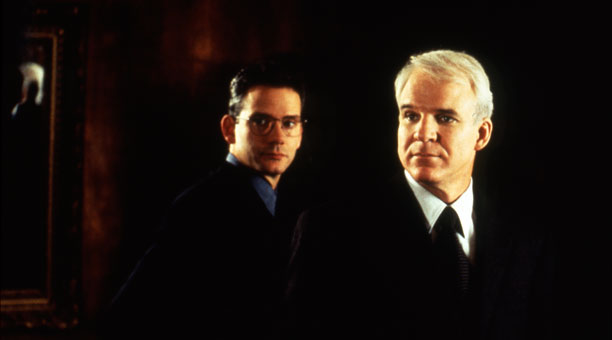Direct Talk
I just read David Mamet's On Directing Films. I enjoy Mamet discussing the dramatic arts, not necessarily because he's right, but because he's so bracing. He's got eccentric views, but he's no-nonsense and wants to break down storytelling to its basics, getting rid of the obfuscations so many artistes enjoy to the detriment of their work.
Like his essays on playwriting, Mamet believes it's the job of a film to tell a story, and the director to aid in this quest. If you cut something and the story survives, you don't need it. Fancy shots, concerns about subtext and backstory, beautiful scenery, etc. are the sorts of things that get in the way.
It's a short book, not much more than 100 pages, half of which are transcripts of discussions he had with film school students at Columbia. He tries to explain what a director should do, which are basic things, like deciding which shots to take (which should be taken care of during preproduction) and what to tell actors. With the students, he goes through constructing a scene.
First you've got to know what's the objective, to understand the throughline that holds it all together. So the class decides they will construct a scene where a student wants to impress a professor. Mamet asks them to give him the shots that will do it. The first move will be for the protagonist to get to a classroom early--remembering every point along the way is to impress the professor. Second, the student will prepare something with his notebook for the prof. Next, he'll introduce himself and so on until he finally gets to what he wants, which is to get a bad grade changed.
But one thing at a time. How to show getting there early. The class goes through many variations, guided by Mamet, who reminds them to keep it simple, avoid clichés, and don't inflect it--that is, don't busy it up with unnecessarily fancy information that can be hard to shoot and, more important, will get in the way of the audience that just wants to know what will happen next. (Audiences are smart and fill in what's needed, and if you're self-indulgent you're slowing things down and insulting them.)
So what shots show someone early? How about having the student walking down the hall. He gets to the classroom, tries the door, it's locked. He sits down and waits. All visual, all simple. And Mamet's class goes on through the entire scene.
Mamet also writes about what to tell the actors. For the shot of the student walking down the hall and trying the door, just tell the actor to walk down the hall and try the door. You don't even have to tell him it won't open. You might tell him to walk slowly or quickly, but you don't go into motivation, don't worry about what the character is thinking, or where he just came from. The character only exists in this action, and many of these separate bits are what will make up the story. A nail holds up a house, but a nail should look like a nail, not the house itself.
As for camera placement, put it where you feel it'll best tell the audience what the action is. Part of this determination is done subconsciously.
Mamet feels a lot of directors think they should just follow the protagonist around. That's not the way to go about it. To Mamet, a film tells it story though the juxtaposition of shots. Always, the audience must be wondering what happens next. So don't have the actor or the shot try to explain what everything means in microcosm. The meaning is revealed once the shots have all been lined up, one after another.
Indeed, as a director, choice of shots is all you have--and you can't fix things in editing or with the performances, it's got to be there to begin with. Good dialogue can make it better, bad dialogue worse, but can't save it either.
And always keep it simple. No one sits down on a park bench and says "I need a rest because I'm a Vietnam vet who's been walking around all day going to various government offices to try to get certain funds which are denied me due to the lack of interest from this administration." Most likely the person will sit down and say "screw it!" or sigh or say nothing. That's the shot, and design them so overall they create an effect.
Actually, I think Mamet, at his best, is a fine writer for the stage, but film director? His style is a bit bloodless. He wrote this book over twenty years ago when he only had two films to his credit. Now he's done over ten features, and while some are entertaining, it's not a particularly distinguished group. Still, it's fun to hear his beliefs. If nothing else, his ideas clear away the cobwebs created elsewhere by so much pretentious theorizing.





3 Comments:
Should I recognize the relevance of the three pictures you've included in this review? Don't worry about insulting me. Thanks.
At the risk of insulting you, there are four pictures. The first is Mamet himself, the rest are from movies he directed. The first two are from House Of Games and Things Change, which he'd directed when he wrote this book. The third is from The Spanish Prisoner.
Is this "Cow Tools" all over again?
http://genius.com/909545/Willy-staley-lady-mondegreen-and-the-miracle-of-misheard-song-lyrics/Gary-larson-drew-a-far-side-cartoon-of-a-cow-staring-blankly-at-a-table-upon-which-is-a-set-of-poorly-made-nonsensical-tools-the-cows-brow-appears-furrowed-as-if-it-is-unable-to-decide-which-one-to-use-the-caption-reads-simply-cow-tools
Post a Comment
<< Home